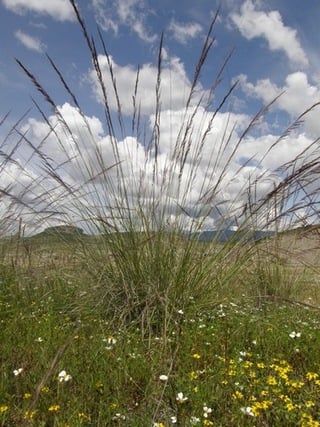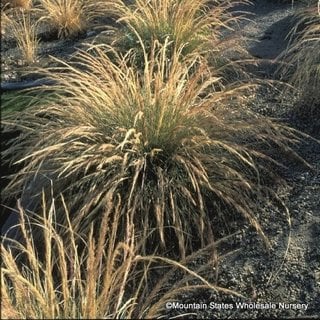Purple muhly is an ornamental grass related to the more common pink muhly. While not showy, it is lovely in an understated way and deserves a place in desert gardens. Here’s how to grow this southwest desert native.

Purple muhly (Muhlenbergia rigida) is a bunch grass that has narrow green-gray leaves that form erect clusters. From late summer to fall, plants send up wispy spikes that wave in the breeze. The striking burgundy seed stalks turn tan as they mature.
As a native to the southwest, it tolerates extreme conditions — heat, sun, and cold.
This graceful grass has a prairie look that makes a great addition to naturalized gardens. Its airy seed stalks soften the harshness of boulders, cactus, and other spiky plants.
Why I Like This Plant
- Airy purple plumes
- Upright form, doesn’t need a lot of space
- Low water use, low maintenance
- No thorns, non-toxic

Things to Watch Out For
It’s not as commonly grown as some of the more popular “muhly” grasses (i.e., pink muhly, big muhly, bamboo muhly), primarily because few nurseries carry it, so it may be hard to find. You won’t find this at a big box store, but you may find it at a nursery that specializes in native plants. (Check out our Tucson Nursery Directory for possible sources.)
Optimal Growing Conditions
If you’re thinking of adding purple muhly to your garden, you need to find a suitable place that will keep your plant healthy and looking good… while minimizing maintenance for you.
Here are the key factors to keep in mind.
Temperature
Purple muhly should be grown in USDA Hardiness Zones 6 – 11. It is cold-hardy down to around -10°F and easily handles extreme heat.
Sun Exposure
Purple muhly performs best in full sun, but it tolerates part shade or the reflected heat from buildings and walls.
Size and Growth Rate
Purple muhly is a moderately fast grower that reaches a size of 3 feet tall and wide.
Soil
In its native habitat, purple muhly grows in gravelly soil. In the garden, it is not fussy and will grow in any native soil — rocky, sandy, or clay — as long as it’s well-draining.
Other Location Considerations
If you have your heart set on a grass with purple inflorescences, purple muhly is a good alternative to purple fountain grass (Cenchrus setaceus ‘Rubrum’). Fountain grass, including the purple cultivar, has been deemed invasive and should not be grown in the southwest.
Because purple muhly’s wispy inflorescences are not spiky, irritating, or toxic so it’s a plant you can feel comfortable placing anywhere it might come in contact with pets and people.
It is litter free so you can grow it near a pool. The only time it’s messy is when it receives its annual trim.
Purple Muhly:
The Essentials
| Common Name | Purple muhly |
| Scientific Name | Muhlenbergia rigida |
| Origin | Southwest US, Mexico, Central & South America |
| Plant Type | Bunch grass |
| USDA Zones | Zones 6 – 11 |
| Cold Hardy | To -10℉ |
| Flower Color | Purple |
| Flower Season | Fall |
| Mature Size | 3’ high x 3’ wide |
| Growth Rate | Moderate |
| Sun Tolerance | Full, part, reflected sun |
| Water Needs | Moderate |
| Pests & Diseases | None |
| Garden Friendly | No thorns, non-toxic, not invasive |
How to Plant
The rule of thumb when planting any ornamental grass is to dig a hole three times as wide as the root ball but no deeper. Amending the soil is not recommended. Counterintuitively, backfilling with the same native soil you just dug up helps your plant develop a stronger root system.
When to Plant
The best time to plant purple muhly is in the fall. This gives your grass three seasons to grow roots and get established before the following summer.
The second best time is in spring, the earlier the better. This still gives your plant time to get established before the intense heat of June arrives.
How to Care for Purple Muhly
Whether you’ve recently planted purple muhly or have an existing plant in your yard, here’s how to take care of it to keep it healthy and looking its best.
How to Water New Plants
As a southwest native, purple muhly needs very little water once established, but it does need regular watering after being planted.
Here is the recommended watering schedule for new ornamental grasses.
| Weeks 1 & 2 | Every 3 – 4 days |
| Weeks 3 & 4 | Every 6 – 7 days |
| Weeks 5 & 6 | Every 7 – 10 days |
| Weeks 7 & 8 | Every 10 – 14 days |
How to Water Established Plants
Once your purple muhly is established, water it deeply every few weeks during the summer. Unlike many other muhly species which are low water use, purple muhly requires a moderate amount of water. In the hottest regions, such as Phoenix, water deeply every week or two during the summer to keep plants looking their best.
If not given adequate water in the summer, plants will go dormant early and you don’t want them to brown out before they’ve had a chance to bloom.
Since plants go dormant in the winter, they only need water once a month, which is typically provided by winter rains.
Should You Fertilize?
There is no need to fertilize purple muhly since it gets all the nutrients it needs from native soil.
How to Prune
Purple muhly should be pruned hard once in late winter or early spring. Cut it down to 3 to 4 inches above the ground.
You can cut it straight across, but slightly irregular cuts look more natural and mimic the grazing that would occur when growing in grasslands. This lets light penetrate the crown and makes way for new spring growth.
Pro Tip!
Tightly tie the dried leaves and flower stalks
with string or duct tape before cutting.
This makes clean-up much easier.
Don’t Confuse Purple Muhly With…
Purple muhly grass is sometimes confused with another southwest native — deer grass — largely because they have very similar scientific names. Even search engines have trouble distinguishing Muhlenbergia rigida (purple muhly) from Muhlenbergia rigens (deer grass), so it’s understandable why gardeners might get them confused, too.
Deer grass is larger (4′ by 4′) and has cream flower stalks, but otherwise, plants are similar in form and care requirements.
Purple Muhly Cultivar
When plant shopping, you may come across the cultivar ‘Nashville’ muhly (Muhlenbergia rigida ‘Nashville’). It has all the same care requirements as the parent plant, but grows only 2 feet tall and wide, making it a great choice for small spaces.

Plant Lover Facts
Purple muhly (Muhlenbergia rigida) has a large native range that includes Arizona, New Mexico, and Texas in the US, and parts of Mexico, Central America, and South America.
The genus, Muhlenbergia, was named after the German botanist Gotthilf Muhlenberg, who is credited with classifying and naming at least 150 plant species.
Muhlenbergia is a genus of 175 grasses, mostly native to the desert southwest. But only a handful are used as landscape plants.
Did you enjoy this article?
Sign up for our weekly newsletter
where you’ll find more great info on creating &
maintaining a beautiful, carefree desert landscape.
Author Bio
Deane Alban is the creator of Southwest Gardener. She is a science writer with a bachelor’s degree in botany from the University of South Florida. Gardening is her lifelong passion. She’s been gardening in Tucson for over 15 years.

Photo Credits
Sue Carnahan, CC BY-SA 4.0, iNaturalist.com
Carlos Martorell, CC BY-SA 4.0, iNaturalist.com
